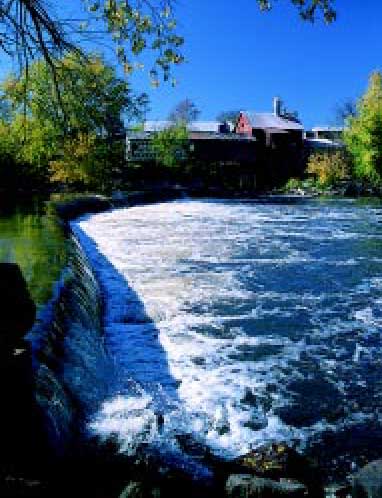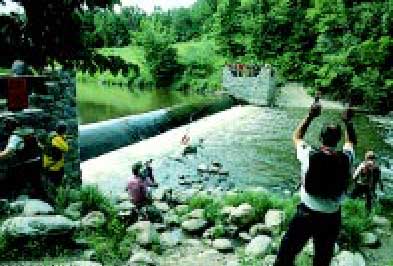by Kim Elverum and Tim Smalley
In late September 1975, a tragic chain of events in Binghamton, New York, taught river users and rescue teams valuable lessons in dam safety. By the time the episode ended a day later, three people were dead and four had been injured.
An early fall storm had made the Susquehanna River unusually high. One evening,
two rafters were swept over the Rock-bottom Dam and trapped in the current below
the structure. Witnesses to the accident summoned help, and a rescue boat was
launched with three firefighters on board. In the turbulent water, the craft
capsized. All three were thrown into the river. One firefighter drowned; the
other two, along with the two rafters, were pulled from the water.
 |
| The Berning Mill Dam on the Crow River near St. Michael, MN was typical of a lowhead dam. Water flowing over the top creates a recirculating current drawing objects back toward the face of the structure. Even boats with powerful engines have been trapped and capsized by lowhead dams such as this one. The dam has now been removed as part of a state dam safety program. |
The next day, on a body recovery operation for the lost firefighter, the fire
chief and two firefighters approached the dam from downstream. As their outboard
powered boat reached the base of the dam, the current caught it and the boat
turned over in the roiling water. Desperate attempts to rescue the trio failed,
including a try with the fire department’s extension ladder.
Twenty minutes later, a rescue boat carrying two sheriff’s deputies arrived on
the scene. By this time, two of the firefighters had disappeared, the third was
bobbing in the maelstrom.
As if to add horror to horror, this attempt once again ended in tragedy as the
third rescue craft overturned in the turbulent water. Luckily, the two deputies
and the remaining firefighter were swept clear of the dam and eventually
rescued. Why did this tragedy occur? Are these small dams that dangerous? Was
this just a freak accident or could it happen in other places, including
Minnesota? What can be done to prevent these tragedies?
DROWNING MACHINE
Dams come in many sizes and shapes, everything from huge lock-and-dam structures
on the Mississippi River to small, “lowhead” dams. Although there are safety
problems with larger dams, their size and design do not present the type of
threat involved in the seemingly harmless lowhead dams.
Lowhead dams are generally small structures usually no more than 10 feet high,
although some are as low as six inches. They have no gates or water control
devices; water flows constantly over them. Most were built to provide water for
grain mills or early hydroelectric generators, and to control lake levels.
Because of their small size, they do not appear to be dangerous, especially when
viewed from a boat or canoe upstream. They can be pleasant places in the summer
when water drops over them and gently flows downstream.
In the spring and during other periods of high runoff, however, the dams become
very dangerous. Torrents of water pouring over the dam create a churning
backwash or current. This “hydraulic,” as it is often called, is really a
recirculating current. The roiling water takes any object — including a person —
to the bottom of the stream, releases it to the surface, sucks it back to the
face of the dam, and pushes it back to the bottom. This cycle can continue
indefinitely.
In addition to the current, other hazards are inherent in most lowhead dams:
• Both faces of the dam usually consist of a vertical concrete abutment. Even if
a victim struggles to the edge of the structure, chances are poor that he or she
will have enough strength to climb the wall.
• Branches and other debris trapped in the hydraulic pose an additional hazard
to the victim.
• Temperature of the water at times of high runoff is usually cold, which
decreases survival time.
• Finally, air bubbles mixing in the water decrease its buoyancy by one-third.
The victim has a hard time staying afloat, even with a personal flotation device
(life jacket).
In sum, these factors combined with the hydraulic current create a nearly
perfect drowning machine.
OUR LOWHEAD DAMS
Problems with these dams are not confined to New York. Deaths of victims and
rescuers have occurred in nearly every state, including our own. Most of the
several hundred lowhead dams in Minnesota were built during the late 1800s and
early 1900s. Many have been abandoned or are no longer used.
One such dam which was removed was located on the Crow River, which forms the
boundary between Hennepin and Wright counties. In July 1979, events nearly as
tragic as the Binghamton incident began with what was alleged to have been a
dare.
A 25-year-old man wearing a boat cushion on his back plunged over the Berning
Mill Dam on an air mattress. The river was unusually high for the summer and the
man was trapped in the hydraulic.
Occupants of two canoes below the dam attempted to rescue him, only to become
victims of the current themselves. The first canoe capsized. Fortunately, the
canoeist was washed clear of the dam and reached shore safely. The second canoe
with two men and a woman was pulled into the spillway. It broke in two throwing
all three occupants into the river.
A state trooper arrived on the scene, but was unable to rescue the man wearing
the boat cushion trapped below the dam. Instead, the trooper turned his efforts
to the woman from the second canoe who had been brought ashore by two fishermen.
He and two bystanders managed to keep her breathing until more help arrived.
That evening she died at the hospital.
Two days later, the bodies were recovered. The final toll: three deaths.
 |
| The MN DNR teaches rescue techniques at a Fast-Water Rescue School. In a drill, a rescue team pulls a float through the boil. A victim caught in the boil could hang onto the float and be pulled free. |
As tragic as these deaths were, however, they were not unique. Over the past 10
years, 14 deaths have occurred at dams on Minnesota rivers. The dam which has
claimed the most lives is the Red River’s Drayton Dam located on the
Minnesota-North Dakota border 40 miles north of Grand Forks. Since it was built
in 1964 over a dozen people have died in its spillway. Despite warning signs,
ordinances, and city and state police officers patrolling the site, fishermen
and canoeists continue to press their luck at the base of the dam.
RESCUE
In 1980, officials of the Ohio Department of Natural Resources were dismayed to
learn that, in two years, nine firefighters and police officers in that state
had lost their lives, and others had been injured, in fast-water-rescue
attempts. Additional checking revealed the same type of deaths and injuries had
occurred in other states.
These accidents involved rescue personnel who were injured or killed in what had
been considered routine water emergencies. Typically, the rescue personnel, like
adventuring river users, were confident of their equipment, knowledge, and
experience.
Only a few fortunate rescuers have survived a trip through the current below a
lowhead dam. Dennis Lutz, a Miamisburg, Ohio, firefighter, described his
experience attempting to rescue a teenager:
“You can’t believe how powerful the current is. As my buddy and I approached the
dam, the boat seemed to rise and move rapidly forward. It’s like being caught by
a monster. It just won’t let you go.”
The rescue boat filled with water and capsized as the strong current sucked it
into the dam. Lutz was dragged down into the hydraulic, battered along the
bottom, caught in a submerged tree, wrenched free, and pushed to the surface,
only to have the cycle repeated. Lutz was finally rescued, but his companion and
the teenager drowned.
In response to these tragedies, the Ohio DNR Division of Watercraft, with the
assistance of firefighters, the Red Cross, and canoeists, developed techniques
that can help anyone faced with a fast-water rescue problem.
The techniques that Ohio devised have been put into practice across the U.S.
Lowhead dam rescues are either shore- or boat-based. Shore-based rescues are
used on dams up to 300 feet wide which have accesses at both ends. If rescue by
a throw-line is not possible, a line with a rescue buoy in the center is placed
across the river. This can be done with a line gun, or by using a boat
downstream from the dam. Rescuers on both sides of the river then work the line
up to the victim and pull the victim to shore.
Dams where access to both ends is not possible, or dams that are wider than 300
feet, generally require a boat-based rescue. This method requires two boats
which are connected by a safety line.
The first boat approaches the dam from downstream, being careful not to enter
the hydraulic. A flotation device on a line is then cast to the trapped person.
The second boat remains 100-150 feet downstream. Its purpose is to assist in the
rescue and keep the first craft from being pulled into the dam.
Other techniques have also been used successfully, including specialized
watercraft and a coupling which allows an ordinary fire hose to be inflated with
compressed air and pushed out to the victim.
Rescue techniques must be realistic and simple. Rescue agencies must know the
dams in their area, take measures to prevent accidents, and plan and practice
rescue methods.
Kim A. Elverum and Tim Smalley. Photos by Tim Smalley.
www.dnr.state.mn.us/boating